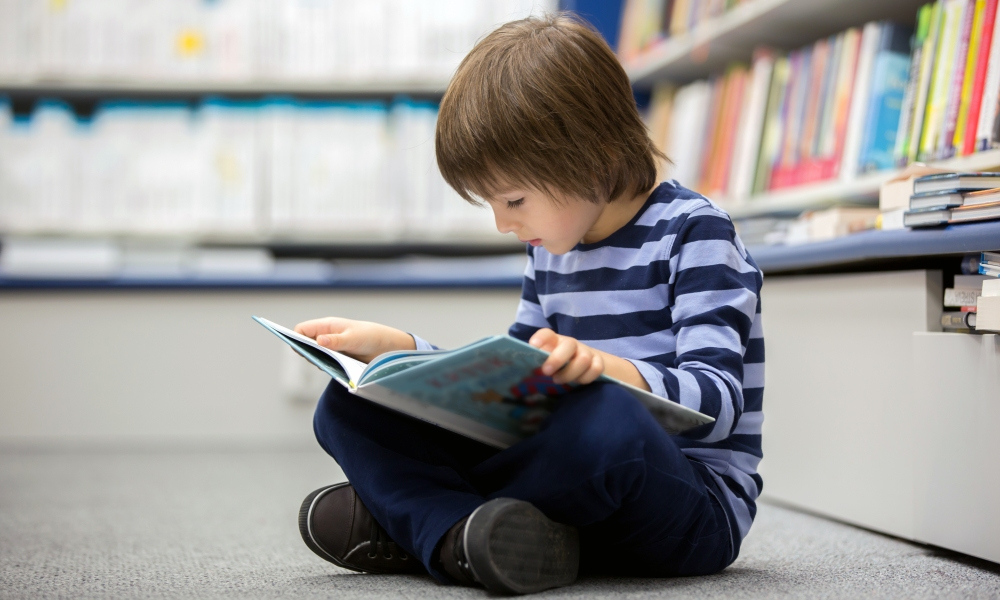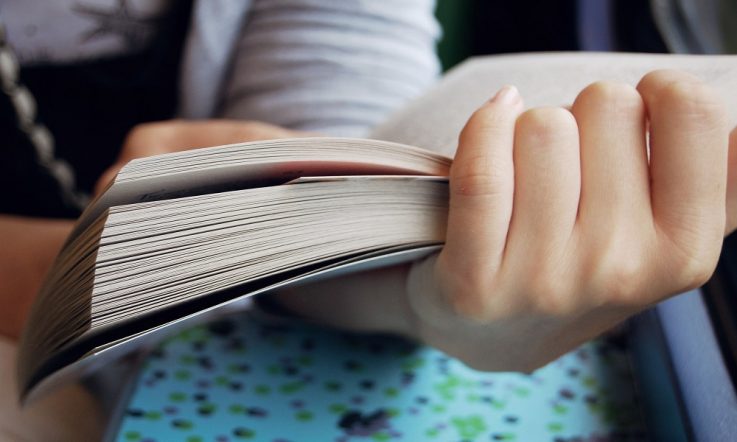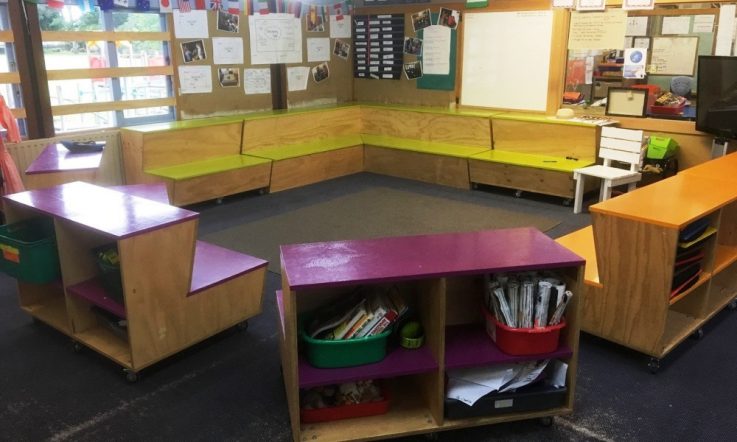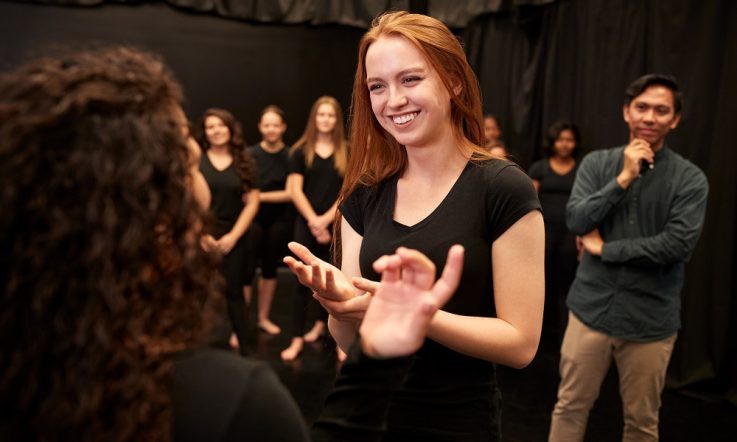Award-winning Teacher Librarian Megan Daley's new book Raising Readers: How to nurture a child's love of books features practical advice, book recommendations and activity ideas for educators and parents.
In this extract for Teacher readers – taken from the chapter Spaces for Reading – Daley shares her tips for designing and stocking a dedicated recreational reading area in your classroom and how to create inviting library spaces for your school.
The reading classroom
Classrooms need an area or zone dedicated to recreational reading. I vividly recall my first year of teaching and the reading zone I created in my Year Two classroom because I think it remains my favourite to this day: acres of deep purple and bright turquoise tulle, ten oversized turquoise cushions covered in purple stars (thank you, Nan, for making those), framed pages torn out of old books and a selection of beautiful books that I changed each week at the school library and displayed in baskets and on the windowsill. When I eventually moved from the classroom to the library, the tulle came with me and my first library was a riot of colour and texture (but, I promise, not an assault to the eyes because I did stick to just a few colours – clearly I have missed my calling as a home stylist).
While there are some fabulous reading spaces in classrooms all over Instagram and Pinterest, I think it's important that you work with the interests of the students and allow them to create the space with you. It can even become a curriculum-related task. The main things for students to think about should be how the books will be arranged, how key books will be displayed and ‘advertised', how to make the space comfortable (chairs, cushions or bean bags), how often books will be changed and by whom, and what colours or innovative features should be used to invite and welcome readers to the space. When the students are a part of the process, it gives them a sense of ownership and they are more likely to feel comfortable using the space. This is also a perfect way to involve reluctant readers in a reading-related task that will have a positive outcome for everyone.
How you stock your classroom library is also an important consideration and books should be changed up regularly to keep interest high. With most of the classroom libraries at school, we library staff send new books each term ensuring a mix of fiction, non-fiction, chapter books and illustrated texts. There are also a number of classrooms where students are assigned the weekly task of ‘librarians'. These students manage the books in the classroom reading zone and swap some out each week, tidy them and refresh displays.
Inviting library spaces
School library spaces are public spaces and should consider the needs of the learners as well as the needs of the educators and the entire school community. Our students need a balance of spaces from expansive, active and social, to small, intimate and quiet with technology infused rather than glaringly obvious [Freeman, 2007]. Teachers need spaces to withdraw individual students for testing and areas for whole class research. Social learning spaces might be needed for small groups to discuss and debate or for students to read aloud in a group context. Conversely, students also appreciate and seek refuge from a busy day in small reading nooks and quiet, reflective spaces.
In 33 Educational Design Principles for Schools and Community Learning Centres, Lackney talks of creating ‘alcoves for learning' centrally located and close to resources [Lackney, 2015]. I love this term and it brings to mind cosy and inviting learning spaces. Many of you will fondly remember those individual, ‘walled' library desks from your own school days; your own little private space where you were meant to work in silence. These went out of vogue as education embraced group work, but more recently we have reconsidered the needs of individuals, and for many students there are moments in a school day when being alone (as alone as one can be in a busy school) can be beneficial to think, create and wonder [Groundwater-Smith, 2004]. In my own school library, we created ‘booths' reminiscent of milk bar booths where students can work alone or in small groups. They are close to the fiction area of the library and often students choose a book and make themselves comfortable in a booth for study or for recreational reading. These ‘alcoves for learning' have probably been the best feature of our library despite the initial worry that they would look a little like school libraries of old!
I could talk endlessly about the importance of displays of books in the library, but instead I'm going to distil this information down to one sentence that I hope will stick in your mind: Library displays should be dotted around the library, be ever-changing, professional (quit the clipart), eye-catching with all books facing forwards and able to be borrowed from the display. (If you're so inclined you can find plenty of ideas and inspiration on Pinterest for themed library displays.)
A final point on library spaces: if at all possible, extend your space into the outdoors (see chapter 11 for more on this). Our school library is the top level of a building, which is not ideal, but we utilise the lovely outdoor areas downstairs for quiet reading, group reading and workshopping. Currently we are doing a unit of work on mindful reading, and many of the students choose to read near our native stingless beehives or in the grove of palm trees.
I am very fortunate to work in a dynamic and constantly evolving library space, which we consider to be meeting the many requirements of a modern learning environment by promoting and supporting a range of pedagogies, including delivering, applying, communicating and creating. Our library offers flexibility and access to the varied resources to support a technologically robust community and one which promotes language and literacy learning at all times.
References
Freeman, G. (2007). Reinventing the library. In D. Kresh, (Ed.), The Whole Digital Library Handbook (pp. 370–374). Chicago: American Library Association.
Groundwater-Smith, S. (2004). Transforming learning: transforming places and space for learning. CEFPI Conference: Faculty design and learning: has the paradigm changed? Sydney: Conservatorium of Music.
Lackney, J. (2015). 33 principles of educational design. The National Clearinghouse for Educational Facilities. Retrieved from: http://schoolstudio.typepad.com/school_design_studio/33-educational-design-pri.html
Author image: Simone C Photography
Raising Readers: How to nurture a child’s love of books by Megan Daley (UQP, rrp $27.95), is out now.
Do you have a recreational reading space in your own classroom? Are students involved in key decisions involving this space and the books that feature in it?
Megan Daley gives a quick checklist of things to remember when displaying books: How many of these apply to your own school library?



